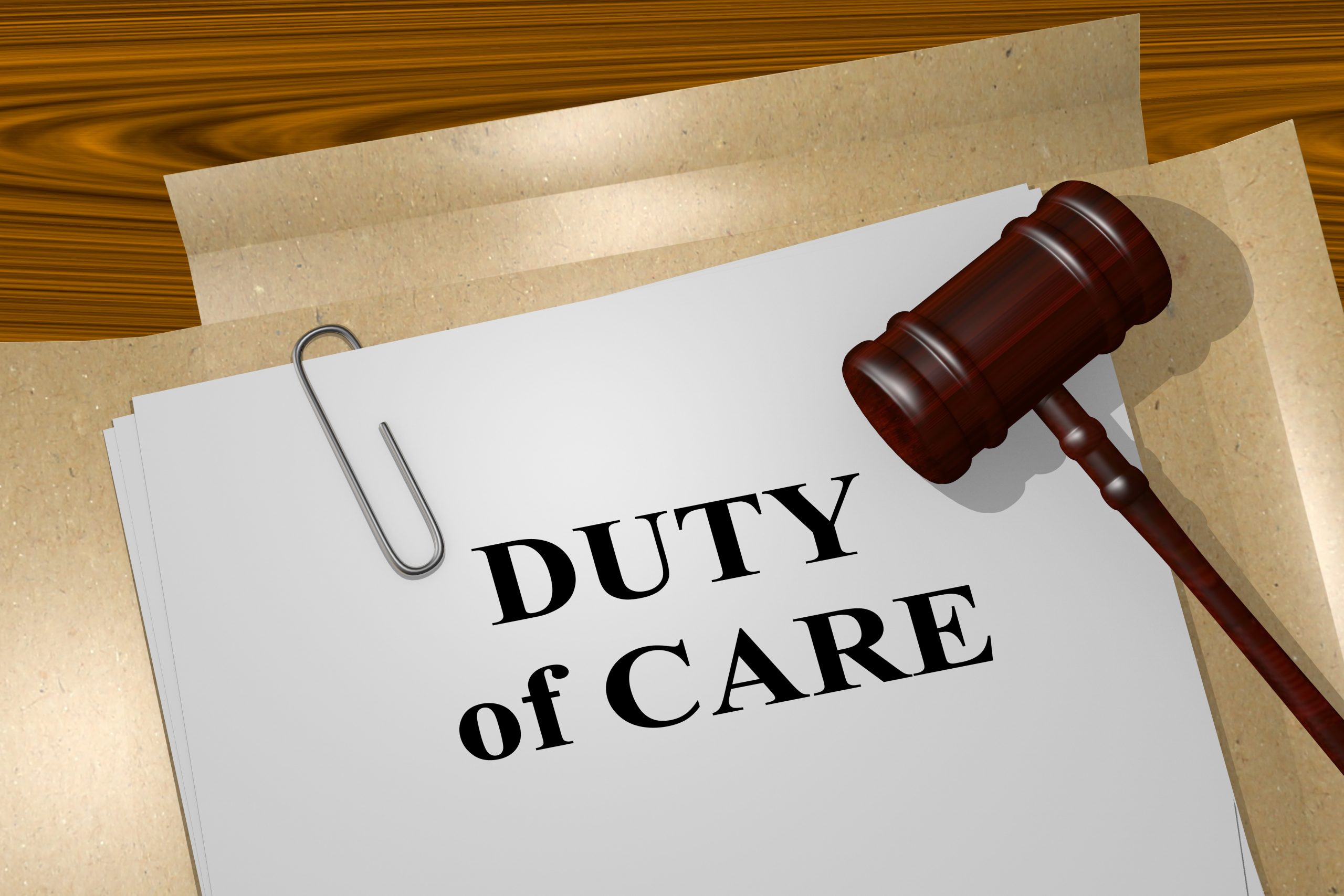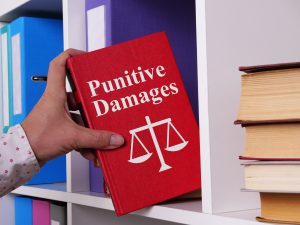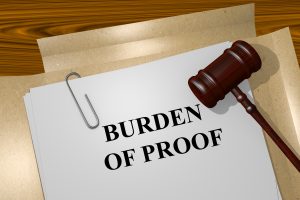What Is The Duty Of Care?
 To prove fault in most personal injury lawsuits, a plaintiff must show that the defendant was negligent. Victims have the burden of demonstrating four legal elements to prove negligence. The first element of negligence is the at-fault party’s duty of care. Typically, this is one of the easiest elements to prove because everyone has a basic obligation to avoid unnecessarily injuring others. The duty to act appropriately is relevant in almost every situation and is often assumed by being in another’s vicinity. In other words, you must implement the same degree of caution and consideration that a reasonable person would exercise given the same situation. Someone does not need to assume the duty of care to another party voluntarily. It can be imposed just by being in a specific place at a specific time.
To prove fault in most personal injury lawsuits, a plaintiff must show that the defendant was negligent. Victims have the burden of demonstrating four legal elements to prove negligence. The first element of negligence is the at-fault party’s duty of care. Typically, this is one of the easiest elements to prove because everyone has a basic obligation to avoid unnecessarily injuring others. The duty to act appropriately is relevant in almost every situation and is often assumed by being in another’s vicinity. In other words, you must implement the same degree of caution and consideration that a reasonable person would exercise given the same situation. Someone does not need to assume the duty of care to another party voluntarily. It can be imposed just by being in a specific place at a specific time.
Breaching The Duty Of Care
The defendant does not need to know you to owe you reasonable care. However, the duty can be based on the relationship of the parties. Additionally, according to New York law, those in certain positions or professions can be held to a higher standard of care to prevent harm. After determining that a defendant owed you a duty of care, you must show how they breached it. A breach arises when an individual’s actions or inactions fail to meet the appropriate standard of care. When a defendant is required to act a certain way and fails to do so, they may be regarded as having breached their duty. Depending on the circumstances, the standard can be breached in numerous ways. Some common examples of breaches include:
 Buffalo Personal Injury Lawyer News
Buffalo Personal Injury Lawyer News


 If you have suffered severe injuries in an accident caused by someone else, it only seems fitting that the person or business should be held liable for your losses. Unfortunately, personal injury cases are not always as straightforward as most people think. While the victim has to prove that the other party was negligent, it is not uncommon to see the insurance adjusters or defense lawyers raise defenses. When certain defenses are successfully demonstrated, at-fault individuals may be able to wholly or partially avoid legal responsibility.
If you have suffered severe injuries in an accident caused by someone else, it only seems fitting that the person or business should be held liable for your losses. Unfortunately, personal injury cases are not always as straightforward as most people think. While the victim has to prove that the other party was negligent, it is not uncommon to see the insurance adjusters or defense lawyers raise defenses. When certain defenses are successfully demonstrated, at-fault individuals may be able to wholly or partially avoid legal responsibility. In a personal injury or wrongful death lawsuit, the plaintiff may be eligible to obtain damages for their losses resulting from a defendant’s negligence. These damages are typically compensatory, meaning that they are designed to compensate victims for their actual injuries. Compensatory damages can be economic and non-economic, such as medical expenses, physical therapy costs, lost wages, property damage, pain and suffering, loss of enjoyment, and loss of consortium.
In a personal injury or wrongful death lawsuit, the plaintiff may be eligible to obtain damages for their losses resulting from a defendant’s negligence. These damages are typically compensatory, meaning that they are designed to compensate victims for their actual injuries. Compensatory damages can be economic and non-economic, such as medical expenses, physical therapy costs, lost wages, property damage, pain and suffering, loss of enjoyment, and loss of consortium.  Under New York law, a victim who pursues damages, also known as a plaintiff, has the burden of proof. In other words, the plaintiff must present evidence to establish the legal elements required to prove the particulars of their claim.
Under New York law, a victim who pursues damages, also known as a plaintiff, has the burden of proof. In other words, the plaintiff must present evidence to establish the legal elements required to prove the particulars of their claim.  Being the victim of an accident can be an extremely traumatic event, especially if you have suffered injuries, property damage, or other significant losses. Even seemingly minor accidents can have disastrous repercussions, such as life-long disabilities, permanent disfigurements, complete paralysis, and traumatic brain injuries. Since most accidents are unpredictable and transpire with little to no warning, victims are usually uncertain about their next steps. The last thing any accident victim wants to worry about is filing the proper forms. With a highly experienced personal injury attorney, the legal process after an accident does not have to be overwhelming.
Being the victim of an accident can be an extremely traumatic event, especially if you have suffered injuries, property damage, or other significant losses. Even seemingly minor accidents can have disastrous repercussions, such as life-long disabilities, permanent disfigurements, complete paralysis, and traumatic brain injuries. Since most accidents are unpredictable and transpire with little to no warning, victims are usually uncertain about their next steps. The last thing any accident victim wants to worry about is filing the proper forms. With a highly experienced personal injury attorney, the legal process after an accident does not have to be overwhelming.  Being the victim of an accident resulting from another’s negligence or recklessness can have earth-shattering ramifications. Victims who sustain serious injuries forfeit small fortunes in lost incomes, medical bills, and rehabilitation costs. Not to mention, many suffer from severe physical, psychological, and emotional complications. Obtaining reasonable compensation for your injuries is often the best way to start recovering. After suffering severe accident-related injuries, victims frequently pursue personal injury lawsuits to recoup their losses. One of the main types of compensation that courts award to plaintiffs is called special or economic damages.
Being the victim of an accident resulting from another’s negligence or recklessness can have earth-shattering ramifications. Victims who sustain serious injuries forfeit small fortunes in lost incomes, medical bills, and rehabilitation costs. Not to mention, many suffer from severe physical, psychological, and emotional complications. Obtaining reasonable compensation for your injuries is often the best way to start recovering. After suffering severe accident-related injuries, victims frequently pursue personal injury lawsuits to recoup their losses. One of the main types of compensation that courts award to plaintiffs is called special or economic damages. Suppose you have been seriously injured in an accident because of another’s wrongdoing. You may be eligible to pursue monetary compensation through a personal injury lawsuit. However, to hold the other party financially liable for your damages, you must first prove that they were negligent. Understanding the legal elements of negligence can help you win your Buffalo, New York injury claim.
Suppose you have been seriously injured in an accident because of another’s wrongdoing. You may be eligible to pursue monetary compensation through a personal injury lawsuit. However, to hold the other party financially liable for your damages, you must first prove that they were negligent. Understanding the legal elements of negligence can help you win your Buffalo, New York injury claim.  Victims often turn to personal injury claims to recoup their losses after being injured in accidents. If the verdict is in the plaintiff’s favor, they can obtain a monetary award for their losses. One type of damage awarded to victims is called compensatory damages. Compensatory damages are designed to pay victims money to cover the costs related to their injuries and other losses. In other words, this type of damage is awarded to compensate plaintiffs for the actual losses they have suffered. For instance, if a careless motorist smashed into your car and totaled it, the compensatory damages would equal the fair market value of your vehicle when it was demolished, minus the salvage value or any usable parts. The two types of compensatory damages that courts can award to plaintiffs are special damages and general damages.
Victims often turn to personal injury claims to recoup their losses after being injured in accidents. If the verdict is in the plaintiff’s favor, they can obtain a monetary award for their losses. One type of damage awarded to victims is called compensatory damages. Compensatory damages are designed to pay victims money to cover the costs related to their injuries and other losses. In other words, this type of damage is awarded to compensate plaintiffs for the actual losses they have suffered. For instance, if a careless motorist smashed into your car and totaled it, the compensatory damages would equal the fair market value of your vehicle when it was demolished, minus the salvage value or any usable parts. The two types of compensatory damages that courts can award to plaintiffs are special damages and general damages. Victims suffer injuries in tens of millions of severe accidents every year, such as slips and falls, collisions, and dog bites. Most of these injuries are caused by someone else’s negligence or even recklessness. The consequences of being involved in an accident can range from serious personal injuries and post-traumatic stress disorder to the destruction of property and costly hospital bills. Over 40 million accident victims require medical care due to various personal injuries each year. If you or a loved one have been injured due to someone else’s negligence, you may be wondering what type of lawyer to call.
Victims suffer injuries in tens of millions of severe accidents every year, such as slips and falls, collisions, and dog bites. Most of these injuries are caused by someone else’s negligence or even recklessness. The consequences of being involved in an accident can range from serious personal injuries and post-traumatic stress disorder to the destruction of property and costly hospital bills. Over 40 million accident victims require medical care due to various personal injuries each year. If you or a loved one have been injured due to someone else’s negligence, you may be wondering what type of lawyer to call. Injured accident victims often wonder if they will receive compensation for their hospital bills and other medical expenses. In personal injury lawsuits involving slips and falls, dog bites, or even food poisonings, tortfeasors are supposed to pay the victims. However, consulting with a highly experienced personal injury attorney is extremely important. Obtaining the right legal advice and proper guidance can make a huge difference in receiving enough compensation to cover your medical bills.
Injured accident victims often wonder if they will receive compensation for their hospital bills and other medical expenses. In personal injury lawsuits involving slips and falls, dog bites, or even food poisonings, tortfeasors are supposed to pay the victims. However, consulting with a highly experienced personal injury attorney is extremely important. Obtaining the right legal advice and proper guidance can make a huge difference in receiving enough compensation to cover your medical bills.